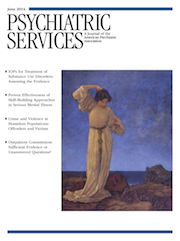Criminal Behavior and Victimization Among Homeless Individuals With Severe Mental Illness: A Systematic Review
Abstract
Objectives
The objectives of the systematic review were to estimate the prevalence and correlates of criminal behavior, contacts with the criminal justice system, and victimization among homeless adults with severe mental illness.
Methods
MEDLINE, Embase, PsycINFO, Cumulative Index to Nursing and Allied Health Literature, and Web of Science were searched for published empirical investigations of prevalence and correlates of criminal behavior, contacts with the justice system, and episodes of victimization in the target population.
Results
The search yielded 21 studies. Fifteen examined prevalence of contacts with the criminal justice system; lifetime arrest rates ranged between 62.9% and 90.0%, lifetime conviction rates ranged between 28.1% and 80.0%, and lifetime incarceration rates ranged between 48.0% and 67.0%. Four studies examined self-reported criminal behavior, with 12-month rates ranging from 17.0% to 32.0%. Six studies examined the prevalence of victimization, with lifetime rates ranging between 73.7% and 87.0%. Significant correlates of criminal behavior and contacts with the justice system included criminal history, high perceived need for medical services, high intensity of mental health service use, young age, male gender, substance use, protracted homelessness, type of homelessness (street or shelter), and history of conduct disorder. Significant correlates of victimization included female gender, history of child abuse, and depression.
Conclusions
Rates of criminal behavior, contacts with the criminal justice system, and victimization among homeless adults with severe mental illness are higher than among housed adults with severe mental illness.




